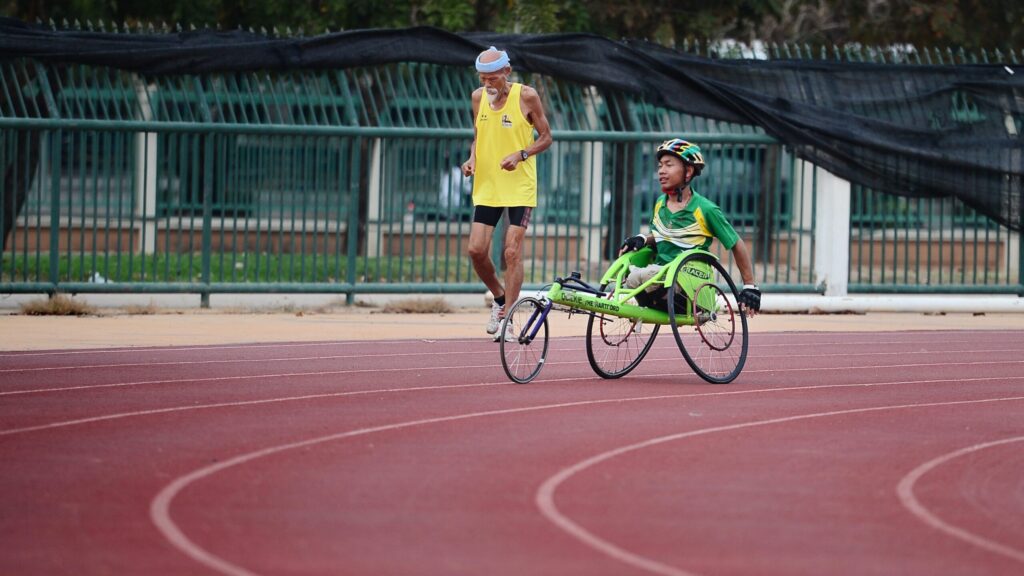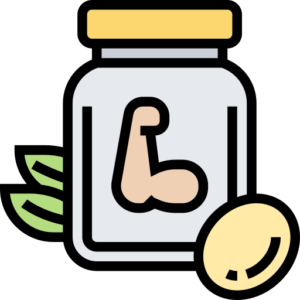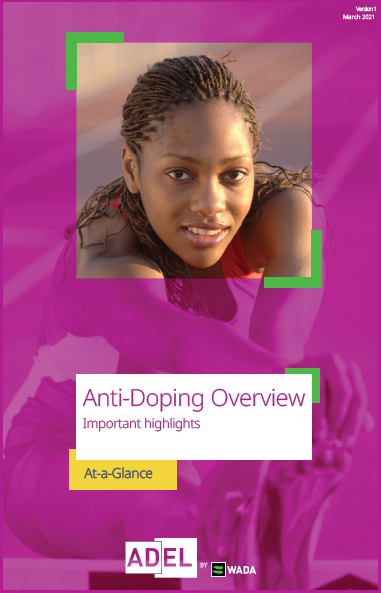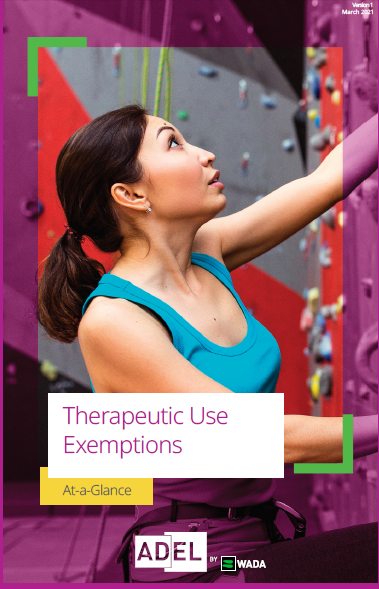
Roles and responsibilities of athletes
Role: Know and comply with all applicable anti-doping policies and rules.
Responsibilities:
- Be available for sample collection at any time for legitimate anti-doping purposes, while respecting personal rights and privacy.
- Take responsibility for what is ingested and used.
- Inform medical personnel of your obligation not to use prohibited substances or methods, and ensure that all medical treatments comply with anti-doping policies and rules.
- Report any decision related to an anti-doping rule violation (ADRV) you have committed in the last ten years to your National Anti-Doping Organization (NADO) and your International Federation (IF), unless this information is already available to them.
- Cooperate with Anti-Doping Organizations (ADOs) investigating ADRVs.

Roles and responsibilities of athlete support personnel and other groups under the Code
Roles:
- Know and comply with all anti-doping policies and rules that apply to you or the athletes you supervise.
- Use your influence on athletes’ values and behavior to promote anti-doping attitudes.
Responsibilities:
- Cooperate with the athlete doping control program.
- If you have committed an anti-doping rule violation (ADRV) in the last ten years, report this information to your National Anti-Doping Organization (NADO) and your International Federation (IF).
- Cooperate with Anti-Doping Organizations (ADOs) investigating ADRVs.
Principle of strict liability
This is a rule that stipulates, under articles 2.1 and 2.2 (World Anti-Doping Code), that it is not necessary for the anti-doping organization to demonstrate intent, fault, negligence, or conscious use by the athlete in order to establish an anti-doping rule violation.
The athlete is strictly liable for any substances found in their biological sample (urine, blood), and for anything in their body. The mere presence of a prohibited substance is sufficient to establish a violation of anti-doping rules, regardless of whether the athlete intended to dope or not; they will have to answer for it on a disciplinary level.
Whatever the circumstances, the athlete must take precautions by verifying that any product they consume (medication or dietary supplement) does not contain any prohibited substances. The athlete must inform all healthcare professionals they consult of their status and the sport(s) they practice.
Consequences of doping
Health consequences
Physical level: damage to vital organs: heart, kidneys, liver, intestines, lungs…, sexual disorders, cancers, damage to muscles and bones…
Psychological level: behavioral changes, loss of self-control, aggressiveness, addiction, mood disorders, decreased concentration…
Sporting consequences
- Training bans
- Loss of results
- Loss of medals
- Loss of titles
- Loss of prizes
- Potential end of career
Ethical consequences
- Damage to the fundamental values of sport, such as courage, honesty, respect for the rules and other competitors, and being a role model.
Social and professional consequences
- Loss of sponsors
- Loss of identity
- Loss of rights
- Loss of income
- Guilt
- Stigmatization
- Isolation
- Embarrassment
- Shame

International Standard for the List of Prohibited Substances and Methods (the List)
About the List
Since 2004, the World Anti-Doping Agency (WADA) has published the List of Prohibited Substances and Methods (the List) annually.
The List is one of the eight International Standards of the World Anti-Doping Code (the Code). The List identifies substances and methods prohibited in sport. Some substances and methods are only prohibited in competition, while others are prohibited at all times. Certain substances and methods are prohibited beyond specific concentrations (decision limits). Some substances and methods are prohibited in certain sports. The substances and methods on the List are classified by categories (e.g., steroids, stimulants, gene doping).
The List of substances and methods included in each category is not exhaustive. These are just examples of the types of substances that would be included in that category.
Criteria for adding a substance or method to the List
For a substance or method to be added to the List, it must meet two of the following three criteria:
- It has the potential to enhance or effectively enhances sports performance.
- It poses an actual or potential risk to the athlete’s health.
- It violates the spirit of sport.
List review process
At least once a year, the List is reviewed through a comprehensive consultation process, which includes the List Expert Group gathering information on:
- The latest scientific and medical research;
- Doping trends; and
- Information collected from law enforcement and emerging developments.
A draft List is circulated to the anti-doping community for feedback, and a revised draft by the List Expert Group is reviewed by WADA’s Health, Medical, and Research Committee. The Health, Medical, and Research Committee then recommends the List to WADA’s Executive Committee, which approves the List at its September meeting. The List is published on October 1st, three months before it comes into effect, so that athletes, athlete support personnel, and stakeholders have time to familiarize themselves with any changes.
The importance of familiarizing yourself with the List
Those under the jurisdiction of the Code must familiarize themselves with the List to avoid unintentional doping. Ultimately, athletes are responsible for prohibited substances found in their bodies and for the prohibited methods used. This is the principle of strict liability. Athlete support personnel can also be sanctioned if they:
- Administer or attempt to administer a prohibited substance;
- Administer or attempt to administer a prohibited method; or
- Possess a prohibited substance or method without medical justification.
Athletes or their support personnel should contact their Anti-Doping Organization (ADO) if they are unsure about the status of a substance and/or method. Athletes who have a legitimate medical reason to use a prohibited substance or method may apply for a Therapeutic Use Exemption (TUE).

Risks associated with dietary supplements
In general, dietary supplements are manufactured products such as pills, capsules, powders, gels, drinks, and bars that contain nutrients, herbs, amino acids, or other substances that can affect the body. They are usually available over-the-counter and are intended to “supplement” the diet.
But be aware that legally available products on the market may be harmful to your health, have negative effects on your performance, and cause a positive doping test.
The reality is that the regulation of dietary supplement manufacturing may be less strict than that of medicines. And even when the manufacture and sale of dietary supplements are strictly regulated in some countries, these regulations are often not enforced.
This means that the ingredients a dietary supplement contains, their quality (their level of purity), the way they are listed on the label, and where the supplement is purchased can pose risks.
Dietary supplements are one of the main causes of inadvertent doping.
Using dietary supplements can be risky because they may contain prohibited substances listed on the List and can be harmful to your health.
The main risks associated with using dietary supplements:
- Some dietary supplements contain prohibited substances.
- Some dietary supplements have been contaminated with prohibited substances during the manufacturing process.
- Some dietary supplements list/name ingredients differently from how they appear on the List.
- Some dietary supplements sold online may not be legitimate products – counterfeit products exist.
Remember to do your research and seek the help of a healthcare professional whenever possible. Your health and athletic career could be at risk!
Before using a dietary supplement, consider bringing it to a healthcare professional for review with you and to confirm an appropriate dosage.
And, if you use a dietary supplement:
- Keep a small amount of it; if you test positive, at least you will have the possibility to have your remaining sample scientifically analyzed to see if it was contaminated.
- Keep the batch certificate of analysis.
- Keep proof of purchase, such as a receipt.
- Keep a record of when you take it and the amount you take.
EDUCATIONAL RESOURCES
“At a Glance” book collection made by WADA explain in a easy manner some concepts and procedures related to doping, therapeutic use exemptions, doping control process, etc.
Here you will find them all and other interesting resources like the Athlete Reference Guide to 2021 Code. If you have any doubts of just feel like exploring more in deep any other concept you will find more information, resources, and webinars in the ADEL website.
Doping control procedure
Doping controls are one of the tools used by Anti-Doping Organizations (ADOs) to create a fair environment and protect clean sport.
If you participate in a national or international competition, you may be subject to a doping control. Athletes can be tested at any time and anywhere.
Urine or blood samples are collected by trained and accredited doping control personnel to detect the presence of prohibited substances. Never forget that when you are selected for a doping control, you must follow a series of rights and responsibilities. Some examples are listed below.
Notification
The athlete is informed by a Doping Control Officer (DCO) or a chaperone that they have been selected for a doping control (test) and under which ADO’s authority the test is being conducted.
Presentation at the doping control station
The athlete must immediately report to the doping control station (though they may be excused for a medal ceremony, for example, after signing in).
Selection of the collection container (urine sample) or the blood collection kit
The athlete chooses a urine sample collection container from a selection provided by the doping control personnel.
For a blood sample, the athlete selects a collection kit from a selection provided by the doping control personnel.
Sample collection
The DCO or chaperone observes the athlete providing the urine sample when the athlete is ready to do so.
A Blood Collection Officer (BCO) collects the athlete’s blood sample using two vials (which will become the A and B samples).
Selection of the sample collection kit (urine)
The athlete selects a sample collection kit from a selection provided by the doping control personnel.
Sample division
The athlete divides their urine into the A and B vials and keeps the remaining urine in the collection container. The B sample allows the athlete to request a second analysis if the A sample shows an abnormal (i.e., positive) result.
If a blood sample is collected, it is divided into the A and B vials. A single vial may be used if the blood sample is collected as part of the Athlete Biological Passport (ABP).
Sealing of the samples
The athlete seals the A and B vials.
Measurement of specific gravity (urine)
The DCO measures the specific gravity of the athlete’s urine to determine if the sample meets laboratory standards. If the sample is too diluted, the athlete is asked to provide additional samples.
Completion of the Doping Control Form
The athlete must complete the Doping Control Form (DCF), either in paper or digital format, with the DCO. The athlete must provide personal information, a list of substances or methods used, and any comments regarding the doping control process. The athlete receives a printed or digital copy of the DCF.
Sending the sample to the laboratory
The athlete’s sealed sample is secured and sent to a WADA-accredited laboratory. A blood sample collected for the ABP may be analyzed by a WADA-approved laboratory. The copy of the DCF sent to the laboratory accompanying the sample is anonymized: it only includes the vial number, the athlete’s sport, and gender.




